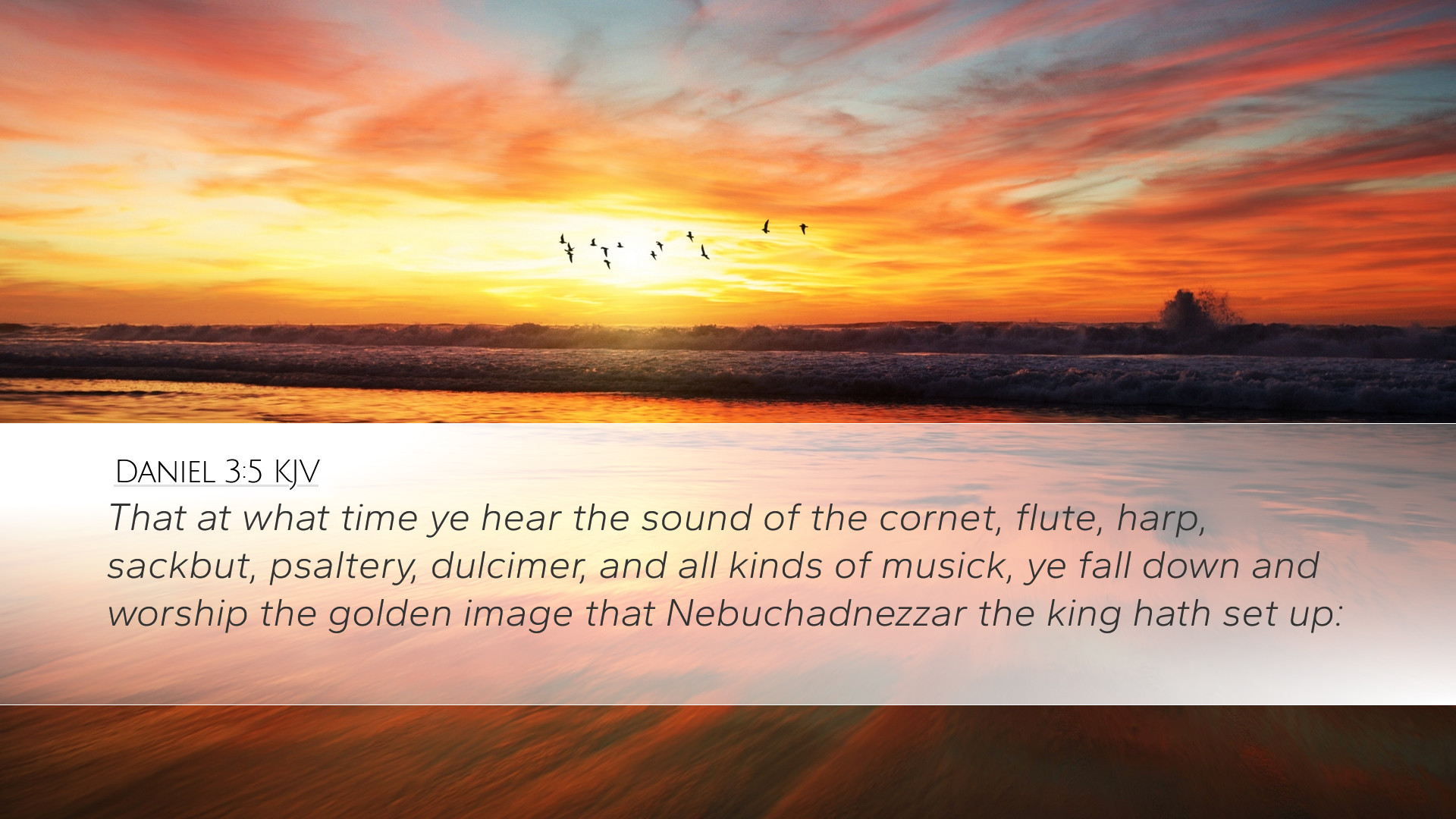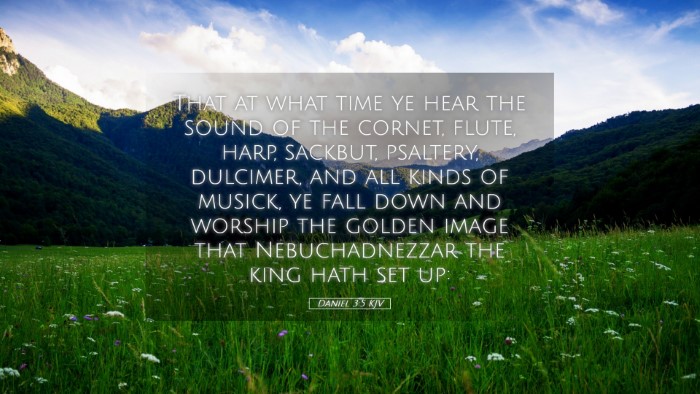Commentary on Daniel 3:5
Verse Context: Daniel 3:5 reads as follows: "That at what time ye hear the sound of the cornet, flute, harp, sackbut, psaltery, and all kinds of music, ye fall down and worship the golden image that Nebuchadnezzar the king hath set up." This verse is part of a larger narrative that depicts the challenge faced by Shadrach, Meshach, and Abednego, emphasizing themes of idolatry, obedience, and the consequences of faithfulness to God.
Insights from Matthew Henry
Matthew Henry draws attention to the authority of King Nebuchadnezzar and the importance of the decree. He notes the ceremonial nature of the musical summons which he believes signifies an orchestrated insistence on worshiping the idol. The king sought to unify the people under a singular act of worship to reinforce loyalty to himself as the sovereign.
- Idolatry Exposed: Henry points out that this event offers a critical insight into the nature of idolatry. The use of music as a tool to evoke a response from the populace illustrates how earthly powers manipulate art forms for their agendas.
- Corporate Pressure: The act of worship commanded was not to be an individual decision but a public spectacle, highlighting the societal pressure to conform to the king's demand.
- Divine Sovereignty: Despite the king's decree, the narrative ultimately affirms God's sovereignty over earthly rulers, suggesting that true worship is reserved for the Creator alone.
Insights from Albert Barnes
Albert Barnes emphasizes the significance of music in ancient cultures, noting that it played a pivotal role in worship practices. In his commentary on this verse, he highlights several key points:
- Instrumental Worship: Barnes underscores the use of various instruments as a means of creating a festive atmosphere, which served to draw the people into a communal act of worship—a tactic likely aimed at enhancing compliance among the subjects.
- Fear of Retribution: The potential consequences of disobedience (which would later be explored in the narrative) instilled fear in the hearts of the people, showcasing how threats can coerce outward worship, regardless of internal belief.
- Symbolism of the Golden Image: The golden image represents not only a physical idol but also the broader temptation to prioritize earthly authority over divine command, prompting the audience to reflect on modern applications in their personal lives.
Insights from Adam Clarke
Adam Clarke presents a thorough examination of the cultural and historical context surrounding Daniel 3:5. He articulates his observations with an emphasis on the implications for faith and worship:
- Cultural Context: Clarke highlights the Babylonian culture's reliance on external displays of faith, particularly the use of grandiose imagery and music, which served to underline their religious practices.
- Testing of Faith: The decree acts as a test for the faith of the individuals; it emphasizes that true allegiance to God will manifest even in the face of coercive measures.
- Moral Dilemma: Clarke elaborates on the moral conflict faced by the faithful, where they are compelled to choose between obedience to human authority and fidelity to divine principles—a theme that is relevant in contemporary settings where faith is similarly challenged.
Theological Reflections
In considering the insights from these commentators, several theological reflections emerge:
- Worship and Authority: The text challenges leaders and congregations to reflect on what they prioritize in worship—a challenge to examine whether external pressures dictate their expressions of faith.
- Resisting Idolatry: The sharp admonition against idolatry invites modern believers to evaluate the 'golden images' in their lives, assessing what possesses their loyalty and devotion.
- The Role of Music: The use of music as an integral part of worship raises questions about the role of cultural expressions in faith communities; how can music serve both to glorify God and lead to unintentional idolatry?
- Faith Under Fire: This account encourages believers facing persecution or societal pressures to remain steadfast, bolstering their resolve that true worship is an internal, heart-driven act.
Conclusion
Daniel 3:5 serves as a profound reminder of the ongoing struggle between societal expectations and individual faith. The insights of Matthew Henry, Albert Barnes, and Adam Clarke guide pastors, students, theologians, and Bible scholars in uncovering the depths of this text, prompting critical reflection on the nature of worship, authority, and faithfulness amidst challenges.


